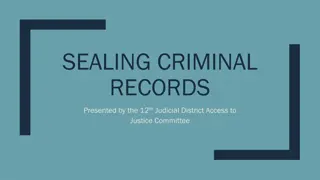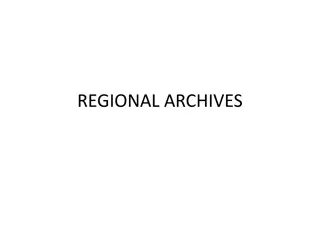National Archives of India: Preserving India's Historical Records
The National Archives of India, established in 1891 in New Delhi, serves as the custodian of government records, providing valuable insight into India's political, social, economic, cultural, and scientific history. Originating from efforts dating back to the British Raj, the archives have played a crucial role in storing and maintaining historical documents for future generations.
Download Presentation

Please find below an Image/Link to download the presentation.
The content on the website is provided AS IS for your information and personal use only. It may not be sold, licensed, or shared on other websites without obtaining consent from the author. Download presentation by click this link. If you encounter any issues during the download, it is possible that the publisher has removed the file from their server.
E N D
Presentation Transcript
NATIONAL ARCHIVES OF INDIA
INTRODUCTION The National Archives of India is the chief repository of the records of the government of India . It serves as the custodian of all government records both past and present . it contains authentic evidence for knowing the Political , Social , Economic , Cultural and Scientific life and activities of the people of India . It was started in 1891, situated in Janpath , New Delhi . Origin of NAI The first organised effort was taken by the Supreme Court which was under the Public Department . The record office existed for about 14 years from 1797 to 1811 with the introduction of Permanent land revenue Settlement In Bengal .
Archival activities , inevitable as the British Raj was A Paper Raj and had a habit of recording every thing . So records had accumulated quite beyand the storing resources of the various departments . For this purpose a general Record office was than established at Fort William , Calcutta. James Hume in 1847 , James Hume , one of the Judges at Calcutta who was for sometime , the Honorary Secretary of the Asiatic Society of Bengal had charted out an excellent plan for the establishment of a Central Record Office , where all records could be maintained well
This steps is materialized in 1860 , as government of India felt that its old records were not properly looked after . Mr . Sandeman , the Civil Auditor , emphasized in his report the need for relieving various offices of the congestion by destruction of papers and advocated transfer of all valuable records to a Grand Central Archives . Record Committee 1861 On the basis of the report of Sandeman , a Committee was constituted in 1861 to examine and deal with the relevant questions regarding old records which had been Accumulation for years together in various departments of the Secretariat at Calcutta and other offices .
Seton Carr was appointed as president of the Committee and Talboys Wheeler , who had prior experience at Madras , as it s Secretary . The Committee submitted it s report on 20th December , 1862 . It recommended for the mention of Scattered valueble public records in a single room . George William Forrest s initiative He was a professor of Elphinestones College , Bombay , He was an Archivist by his personal interest took the lead . He was invited by the government in 1889 and was appointed as an officer on special duty to examine the records of Foreign Department of the government of India .
Report of George William Forrest He submitted a report on 17th Aug , 1889 impressed the necessity of establishing a Central Record Office He recommended that all records relating to the administration of East India Company should be placed in one Central Record Office On 11th March , 1891 , the Government of India employed G. W. Forrest as officer in charge of the records of the Government of India for examining old records in each of the department and organising a Central Library in place of different department . Thus Imperial Record Department ( IRD) came into existed in Calcutta in 1891 .
Growth of NAI Forrest rightly be called as the Father of National Archives of India . By 1891 , all the records of Home Department were transferred and the Central Library was organised . Gradually other records were also deposited . By 1899 all the records were arranged Chronologically as well as in accordance their origin under seven headings 1. Home 2. Foreign 3. Military Board 4. Military 5. Medical Board
6. Surgean General 7. Public works They are in Persian and other oriental languages . S. C. Hill 1899- 1902 Forrest was succeeded by Samuel Charles Hill . He carried on the records Publication work and unearthed a mass of materials which formed in the name of Volumes on Bengal In 1756 57 . The books on Yusuf Khan and the History of the Maratha people were also published . He compiled the Abstract of the Farley Records of the Foreign Department ( 1756 62 )
He prepared a Calendar of the Proceedings of the Select Committee for the period 1750 1760 . He took effective steps for the rehabilitation of fragile papers . He undertook the programme of flattening of folded documents , repaired them . He introduced a superior quality of tracing paper for repairing the records . C. R. Wilson 1902 1904 . He continued the work of C. S. Hill and brought out six Volumes of public press list which covered 8000 Manuscripts and press list of Bengal and Madras papers .
N . L. Hall ward 1904 1905 He published the list of the Home Department records ( 1749 1759 ) and sent a further list of records ( 1859 90 ) to the press . He prepared an Index to the press list of the Public Proceedings from 1749- 1759 and Abstracts of original Persian Correspondence ( 1708 81 ) E .D. Ross : 1906- 1914 He injected a new life into the archival activities . His intellectual calibre and learning in the Persian language paved the way for the publication of Calendar of Persian records . These calendars serves a source of guidance to researchers on Persian records . He made an attempt to prepare an inventory of the records in the custody of the Records Department .
The lists of Foreign Department records in the three volumes , The Military Department records in three volumes and Finance Department records in one volume were published . In 1910 , the Imperial Record Department till then under Home Department , was transferred to the newly created Department of Education A . F. Schotfield : 1914 1919 He became the head of the Archives in 1914 under the new tittle Keeper of Records . He was an excellent Indexer . So he released a Pamphlet entitled Indexing of Records , Which deals with the rules of Indexing for the benefit of learners and as a guidance for Archivists .
An index to the entire series of Public press lists was launched . He replaced the old method of Tracing Paper with that of more enduring Chiffon and less expensive Japanese Tissue Paper . During his tenure , the Indian Historical Commission was set up for the advise the Government of India in matters connected with the Acquisition , Preservation and Historical Research . Schotfield was succeeded by Richard Henry Balker who served the office for 15 months . He started the preliminary work on a Hand book to the Pre- Mutiny Records . As suggested by the Indian Historical Record Commission . Press listing of Mutiny Papers was Completed during Balker s time .
J . M. Mitra - 1920 1922 . He was the first Indian appointed as the head of the Imperial Record Department . He took effective measures for the eradication of termites . A. F. M. Abdul Ali 1922- 1938 He served nearly 17 years . He was an able exponent of Muslim Culture . His period witnessed a number of important events such as the weeding of records . For weeding the Records , The Government constituted a Sub Committee . The Committee concentrated on examining the Pre- Mutiny records . They framed a set of rules for the guidance of the Scrutinizers .
The depression of the 30s which affected the whole worlds Economy . At that time he faced the problem . It impossible to divert funds for the preservation of a colony s culture . In 1911 , the capital had been transferred from Calcutta to New Delhi . All the official records would go with it , the present building was opened in New Delhi on 1st Now , 1926 . The transfer of records was completed by March , 1937 . As per the recommendation of the IHRC Publication works were undertaken . Dodwell s Sepoy Recruitment in the old Madras Army was published in 1922. The Hand book to the Records of the government of India , 1748 1859 published in 1925 .
Dr, S. N. Sen : 1939 1949 . Dr . Surendranath Sen , was a man of vision and foresight . After 1947 Dr . S. N. Sen retired on 31st Oct, 1949 He was succeeded by Dr. Pumendu Basu . On 1st Sep , 1953 , A Committee of Archives of India was constituted with eminent archivists members , to evolve ways and means by which those who were concerned with Archival administration in the country . On 19th Aug , 1959 , the government of India constituted a Committee on Archival Legislation .
On 11thDec , 1972 , the government passed the Policy Resolution Then several archivists like , K. D. Bhargava , Dr. S. N. Prasad , and others served as Directors under whom the NAI witnessed a steady growth . In 1939 , Archives were opened to the Scholars . The Land Revenue Records ( 1830 1959 ) were published In 1940 , A Manual of rules and regulations to archives in India and Europe was published . The Archives made the presence of the trained officers A band of well trained and qualified staff had to replace the existing untrained staff . In 1944 , The Keeper of Records was designated as Director of Archives . The Imperial Record Department was renamed as National Archives of India on 30th Aug , 1947 . _______























